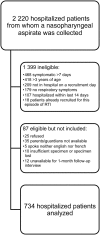Comparison of risk factors for human metapneumovirus and respiratory syncytial virus disease severity in young children
- PMID: 22551815
- PMCID: PMC7114627
- DOI: 10.1093/infdis/jis333
Comparison of risk factors for human metapneumovirus and respiratory syncytial virus disease severity in young children
Abstract
Background: Human metapneumovirus (hMPV) and respiratory syncytial virus (RSV) are leading pediatric pathogens. However, risk factors for severe hMPV disease remain unknown. We comparatively assessed environmental, host, and viral determinants for severe hMPV and RSV infections.
Methods: We studied a prospective cohort of >1000 children aged <3 years hospitalized in or presenting to a pediatric clinic for acute respiratory infection. We collected clinical data at enrollment and 1-month follow-up and tested nasopharyngeal secretions for respiratory viruses. Disease severity was defined as hospitalization and was also assessed with a severity score (1 point/variable) calculated on the basis of fraction of inhaled O(2) ≥ 30%, hospitalization >5 days, and pediatric intensive care unit admission.
Results: hMPV was identified in 58 of 305 outpatient children (19.0%) and 69 of 734 hospitalized children (9.4%), second only to RSV (48.2% and 63.6%, respectively). In multivariate regression analysis of hMPV cases, age <6 months and household crowding were associated with hospitalization. Among hospitalized patients, risk factors for severe hMPV disease were female sex, prematurity, and genotype B infection. Age <6 months, comorbidities, and household crowding were risk factors for RSV hospitalization; breast-feeding and viral coinfection were protective. Age <6 months and prematurity were associated with severe RSV cases among hospitalized children.
Conclusions: hMPV and RSV severity risk factors may differ slightly. These findings will inform hMPV prevention strategies.
Figures
References
-
- Mathers C, Lopez A, Murray C. The burden of disease and mortality by condition: data, methods, and results for 2001. In: Lopez A, Mathers C, Ezzati M, Jamison D, Murray C, editors. Global burden of disease and risk factors. New York: Oxford University Press and the World Bank; 2006. pp. 45–93. - PubMed
-
- Papenburg J, Boivin G. The distinguishing features of human metapneumovirus and respiratory syncytial virus. Rev Med Virol. 2010;20:245–60. - PubMed
Publication types
MeSH terms
Grants and funding
LinkOut - more resources
Full Text Sources
Medical


